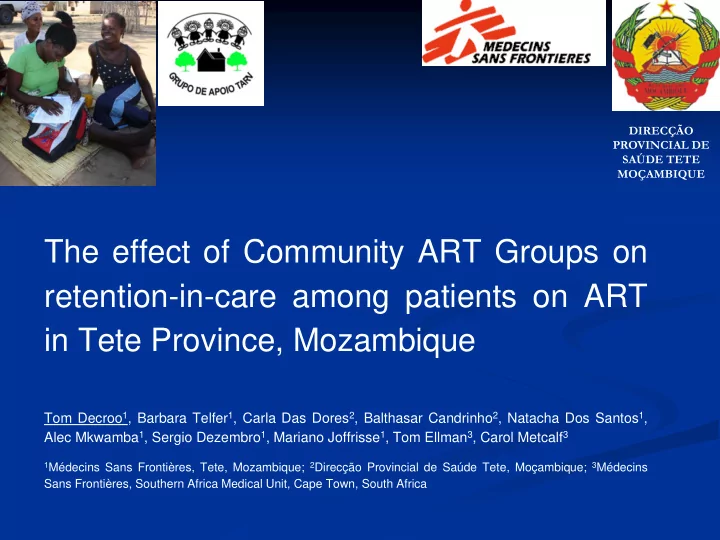

DIRECÇÃO PROVINCIAL DE SAÚDE TETE MOÇAMBIQUE The effect of Community ART Groups on retention-in-care among patients on ART in Tete Province, Mozambique Tom Decroo 1 , Barbara Telfer 1 , Carla Das Dores 2 , Balthasar Candrinho 2 , Natacha Dos Santos 1 , Alec Mkwamba 1 , Sergio Dezembro 1 , Mariano Joffrisse 1 , Tom Ellman 3 , Carol Metcalf 3 1 Médecins Sans Frontières, Tete, Mozambique; 2 Direcção Provincial de Saúde Tete, Moçambique; 3 Médecins Sans Frontières, Southern Africa Medical Unit, Cape Town, South Africa
Mozambique Population 25 million 70% live rural Health workforce gap 10.5% adult HIV prevalence 1 1.5 million live with HIV 1 ART 53% coverage 1 Rural areas: up to 50% attrition @ 3 years 2 ( 1 UNAIDS, 2016; 2 Wandeler, 2012) 2
Tete Province LTFU hampered ART scale-up Distances, queuing, lack of information 1 Tracing not effective 2 Community ART Groups Patients > 6 months on ART and stable join peer groups for refill, reporting & referral ( 1 Caluwaerts, 2009; 2 Posse, 2009) 3
CAG dynamic 4
Research question Does CAG harm? Mixed methods study How does retention-in- care in CAG compare with retention-in-care in conventional care Perceptions of & experiences with CAG (presented elsewhere) 5
Methods Retrospective cohort study File review in 8 clinics Peri-urban (Moatize, Songo) Rural (Changara, Mutarara, Manje, Zobue, Chitima, Boroma) Clinics with > 80 % in CAG were excluded (Missawa, Marara, Kaounda, Mavutze Ponte) Study period: Feb 2008 (start of CAG) – April 2012 6
Methods Study inclusion criteria: Active @ 6 months on ART in the study period 15 - 60 years old Survival analysis Follow-up time: started at “date of 6 months on ART” Outcome: attrition (dead or lost to follow-up) CAG participation: time-dependent covariate Multivariate Cox regression: effect of CAG participation on attrition, adjusted for age, sex & type of health facility 7
Results 9 266 patiënts on ART 8 health facilities Exclusion 3 638 > 6 months on ART before the study period 2 324 < 6 months on ART during the study period 364 aged < 15 or > 60 98 had an unknown age 436 in CAG before 6 months ART 2 406 6 month on ART in the study period Between 15 and 60 years old 8
Results – characteristics N = 2406 n % CAG status Did not join a CAG 1505 62.6 Joined a CAG 901 37.5 Age (years) 15 - 24 371 15.4 25 - 29 515 21.4 30 - 39 945 39.3 40 - 59 575 23.9 Sex Female 1514 63.1 Male 854 36.9 Health facility Rural 1446 60.1 9 Peri-urban 960 39.9
Results – retention in care 97.5% 82.3% P< 0.0001 10
Results – predictors of attrition Retention Attrition HR (95% CI)* aHR (95% CI)* n (%) n (%) Total 2127 (88) 279 (12) - - CAG status Did not join a CAG 1245 (83) 260 (17) 1 1 Joined a CAG 802 (98) 19 (2) 0.17 (0.10-0.28) 0.18 (0.11-0.29) Age (years) 15 - 24 316 (85) 55 (15) 1.52 (1.09-2.11) 1.65 (1.17-2.32) 25-29 460 (89) 55 (11) 0.98 (0.71-1.36) 1.04 (0.75-1.45) 30-39 844 (89) 101 (11) 1 1 40 - 59 507 (88) 68 (12) 1.09 (0.80-1.49) 0.98 (0.72-1.34) Sex Female 1374 (91) 140 (9) 1 1 Male 746 (84) 138 (16) 1.78 (1.41-2.26) 1.80 (1.41-2.30) Health facility Peri-urban 858 (89) 102 (11) 1 1 Rural 1269 (88) 177 (12) 1.07 (0.84-1.37) 1.11 (0.86-1.43) HR= Hazard Ratio; aHR= adjusted Hazard Ratio 11 * Adjusted for calender time (by semester)
Key findings & interpretation Retention in care in CAG higher than in conventional care Effect of CAG on adherence is unknown Qualitative data showed advantages (peer support, less barriers), enablers (counsellors), and pitfalls (selective enrolment in CAG) 1 Limitations Selection bias Potential confounders such as CD4, psycho-social characteristics and distance to clinic not available 12 ( 1 Rasschaert, 2014)
Implications & perspectives Peer-led community-based ART delivery works Continue CAG scale-up Adapt model : Include second-line, TB/HIV co-infected, adolescents, early ART, … Comprehensive community- based care One size doesn’t fit all! 13
Thank you ! Patients, CAG members MSF staff Ministry of Health Richard White 14
Extra slides 15
aHR (95% CI) Male 1.9 (1.5-2.5) 92% CD4 when joining CAG < 200 2.3 (1.6-3.2) CD4 not updated in the CAG 1.9 (1.2-3.0) Rotation not fluent in the CAG 1.7 (1.3-2.3) Clinic type • Peri-urban 1 • District 1.6 (1.1-2.2) • Rural 2.6 (1.8-3.7)
@ CAG: @ Health Facility: . Time & cost savings . Time for sick patients . Protective environment . Information loop . Peer support Need for counsellors Selection (affinity, trust) @ Community: .HIV awareness .Less stigma Information not always correct 17
Recommend
More recommend